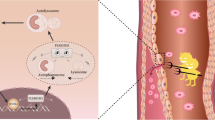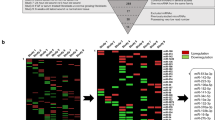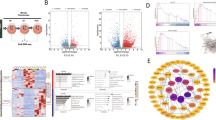Abstract
Osteoarthritis is a heterogeneous disease with a complex etiology. However, there is no effective treatment strategy at present. The purpose of this study was to explore the miRNA‒mRNA regulatory network and molecular mechanism that regulate the progression of osteoarthritis. In this article, we downloaded datasets (GSE55457, GSE82107, GSE143514 and GSE55235) from Gene Expression Omnibus (GEO) to screen differentially expressed mRNAs in osteoarthritis. Then, through weighted gene coexpression network (WGCNA), functional enrichment, protein‒protein interaction (PPI) network, miRNA‒mRNA coexpression network, ROC curve, and immune infiltration analyses and qPCR, the mRNA PLCD3, which was highly expressed in osteoarthritis and had clinical predictive value, was screened. We found that PLCD3 directly targets miR-34a-5p through DIANA and dual-luciferase experiments. The expression levels of PLCD3 and miR-34a-5p were negatively correlated. In addition, CCK-8 and wound healing assays showed that the miR-34a-5p mimic inhibited hFLS-OA cell proliferation and promoted hFLS-OA cell migration. PLCD3 overexpression showed the opposite trend. Western blotting further found that overexpression of miR-34a-5p reduced the protein expression levels of p-PI3K and p-AKT, while overexpression of PLCD3 showed the opposite trend. In addition, combined with the effect of the PI3K/AKT pathway inhibitor BIO (IC50 = 5.95 μM), the results showed that overexpression of miR-34a-5p increased the inhibitory effects of BIO on p-PI3K and p-AKT protein expression, while overexpression of PLCD3 significantly reversed these inhibitory effects. Overall, the miR-34a-5p/PLCD3 axis may mediate the PI3K/AKT pathway in regulating cartilage homeostasis in synovial osteoarthritis. These data indicate that miR-34a-5p/PLCD3 may be a new prognostic factor in the pathology of synovial osteoarthritis.





Similar content being viewed by others
Data availability
Expression profile data (GSE55457, GSE82107, GSE143514 and GSE55235) in this study were from the public database GEO (https://www.ncbi.nlm.nih.gov/geo). All datasets generated for this study are included in the article and supplementary material.
References
Abramoff B, Caldera FE (2020) Osteoarthritis: Pathology, Diagnosis, and Treatment Options. Med Clin North Am 104(2):293–311. https://doi.org/10.1016/j.mcna.2019.10.007
Ali Syeda Z, Langden SSS, Munkhzul C et al (2020) Regulatory Mechanism of MicroRNA Expression in Cancer. Int J Mol Sci 21(5):1723. https://doi.org/10.3390/ijms21051723
Bhattaram P, Jones K (2019) Regulation of fibroblast-like synoviocyte transformation by transcription factors in arthritic diseases. Biochem Pharmacol 165:145–151. https://doi.org/10.1016/j.bcp.2019.03.018
Charlier E, Deroyer C, Ciregia F et al (2019) Chondrocyte dedifferentiation and osteoarthritis (OA). Biochem Pharmacol 165:49–65. https://doi.org/10.1016/j.bcp.2019.02.036
Chen J, Wu W, Zhang M, Chen C (2019) Taraxasterol suppresses inflammation in IL-1β-induced rheumatoid arthritis fibroblast-like synoviocytes and rheumatoid arthritis progression in mice. Int Immunopharmacol 70:274–283. https://doi.org/10.1016/j.intimp.2019.02.029
Chen PS, Lin SC, Tsai SJ (2020) Complexity in regulating microRNA biogenesis in cancer. Exp Biol Med (maywood) 245(5):395–401. https://doi.org/10.1177/1535370220907314
Choi MC, Jo J, Park J, Kang HK, Park Y (2019) NF-κB Signaling Pathways in Osteoarthritic Cartilage Destruction. Cells 8(7):734. https://doi.org/10.3390/cells8070734
Coutinho de Almeida R, Ramos YFM, Mahfouz A et al (2019) RNA sequencing data integration reveals a miRNA interactome of osteoarthritis cartilage. Ann Rheum Dis 78(2):270–277. https://doi.org/10.1136/annrheumdis-2018-213882
Etich J, Rehberg M, Eckes B, Sengle G, Semler O, Zaucke F (2020) Signaling pathways affected by mutations causing osteogenesis imperfecta. Cell Signal. 2020(76):109789. https://doi.org/10.1016/j.cellsig.2020.109789
Gan X, Zhu H, Jiang X et al (2020) CircMUC16 promotes autophagy of epithelial ovarian cancer via interaction with ATG13 and miR-199a. Mol Cancer. 19(1):45. https://doi.org/10.1186/s12943-020-01163-z
Gupta SC, Awasthee N, Rai V et al (2020) Long non-coding RNAs and nuclear factor-κB crosstalk in cancer and other human diseases. Biochim Biophys Acta Rev Cancer. 1873(1):188316. https://doi.org/10.1016/j.bbcan.2019.188316
Han YH, Mun JG, Jeon HD, Kee JY, Hong SH (2019) Betulin Inhibits Lung Metastasis by Inducing Cell Cycle Arrest, Autophagy, and Apoptosis of Metastatic Colorectal Cancer Cells. Nutrients 12(1):66. https://doi.org/10.3390/nu12010066
Han D, Fang Y, Tan X et al (2020) The emerging role of fibroblast-like synoviocytes-mediated synovitis in osteoarthritis: An update. J Cell Mol Med 24(17):9518–9532. https://doi.org/10.1111/jcmm.15669
Han Y, Yu S-M, Shah FH, Kim SJ (2022) Subversive molecular role of Krüppel-like factor 5 in extracellular matrix degradation and chondrocyte dedifferentiation. Funct Integr Genomics 22:1307–1313. https://doi.org/10.1007/s10142-022-00892-2
He J, Zhao H, Liu X et al (2020) Sevoflurane suppresses cell viability and invasion and promotes cell apoptosis in colon cancer by modulating exosome-mediated circ-HMGCS1 via the miR-34a-5p/SGPP1 axis. Oncol Rep 44(6):2429–2442. https://doi.org/10.3892/or.2020.7783
Huang J, Zhao L, Fan Y et al (2019) The microRNAs miR-204 and miR-211 maintain joint homeostasis and protect against osteoarthritis progression. Nat Commun 10(1):2876. https://doi.org/10.1038/s41467-019-10753-5
Kijowski R, Demehri S, Roemer F, Guermazi A (2020) Osteoarthritis year in review 2019: imaging. Osteoarthritis Cartilage 28(3):285–295. https://doi.org/10.1016/j.joca.2019.11.009
Lekka E, Hall J (2018) Noncoding RNAs in disease. FEBS Lett 592(17):2884–2900. https://doi.org/10.1002/1873-3468.13182
Lever J, Jones MR, Danos AM et al (2019) Text-mining clinically relevant cancer biomarkers for curation into the CIViC database. Genome Med 11(1):78. https://doi.org/10.1186/s13073-019-0686-y
Li HL, Duan YA, Zhao N (2021) MiR-34a-5p directly targeting TRIM44 affects the biological behavior of ovarian cancer cells. Eur Rev Med Pharmacol Sci 25(3):1250–1260. https://doi.org/10.26355/eurrev_202102_24829
Lin L, Wen J, Lin B et al (2021) Phospholipase C Delta 3 inhibits apoptosis and promotes proliferation, migration, and invasion of thyroid cancer cells via Hippo pathway. Acta Biochim Biophys Sin (Shanghai). 53(4):481–491. https://doi.org/10.1093/abbs/gmab016
Liu W, Liu X, Wang L et al (2018) PLCD3, a flotillin2-interacting protein, is involved in proliferation, migration and invasion of nasopharyngeal carcinoma cells. Oncol Rep 39(1):45–52. https://doi.org/10.3892/or.2017.6080
Maglaviceanu A, Wu B, Kapoor M (2021) Fibroblast-like synoviocytes: Role in synovial fibrosis associated with osteoarthritis. Wound Repair Regen. https://doi.org/10.1111/wrr.12939.10.1111/wrr.12939
O’Brien MS, McDougall JJ (2019) Age and frailty as risk factors for the development of osteoarthritis. Mech Ageing Dev 180:21–28. https://doi.org/10.1016/j.mad.2019.03.003
Pap T, Dankbar B, Wehmeyer C, Korb-Pap A, Sherwood J (2020) Synovial fibroblasts and articular tissue remodelling: Role and mechanisms. Semin Cell Dev Biol 2020(101):140–145. https://doi.org/10.1016/j.semcdb.2019.12.006
Qi J, Han W, Zhong N et al (2022) Integrated analysis of miRNA-mRNA regulatory network and functional verification of miR-338-3p in coronary heart disease. Funct Integr Genomics 23:16. https://doi.org/10.1007/s10142-022-00941-w
Saliminejad K, KhorramKhorshid HR, SoleymaniFard S et al (2019) An overview of microRNAs: Biology, functions, therapeutics, and analysis methods. J Cell Physiol 234(5):5451–5465. https://doi.org/10.1002/jcp.27486
Schuster R, Rockel JS, Kapoor M, Hinz B (2021) The inflammatory speech of fibroblasts. Immunol Rev. https://doi.org/10.1111/imr.12971.10.1111/imr.12971
Shang F, Wang Y, Ma R et al (2022) Screening of microRNA and mRNA related to secondary hair follicle morphogenesis and development and functional analysis in cashmere goats. Funct Integr Genomics 22:835–848. https://doi.org/10.1007/s10142-022-00842-y
Shen H, Wang Y, Shi W et al (2018) LncRNA SNHG5/miR-26a/SOX2 signal axis enhances proliferation of chondrocyte in osteoarthritis. Acta Biochim Biophys Sin (Shanghai) 50(2):191–198. https://doi.org/10.1093/abbs/gmx141
Somaschini A, Di Bella S, Cusi C et al (2020) Mining potentially actionable kinase gene fusions in cancer cell lines with the KuNG FU database. Sci Data 7(1):420. https://doi.org/10.1038/s41597-020-00761-2
Song AF, Kang L, Wang YF, Wang M (2020) MiR-34a-5p inhibits fibroblast-like synoviocytes proliferation via XBP1. Eur Rev Med Pharmacol Sci. 24(22):11675–11682. https://doi.org/10.26355/eurrev_202011_23812
Sordo-Bahamonde C, Lorenzo-Herrero S, Payer ÁR, Gonzalez S, López-Soto A (2020) Mechanisms of Apoptosis Resistance to NK Cell-Mediated Cytotoxicity in Cancer. Int J Mol Sci 21(10):3726. https://doi.org/10.3390/ijms21103726
Sun X, Zhen X, Hu X et al (2019) Osteoarthritis in the Middle-Aged and Elderly in China: Prevalence and Influencing Factors. Int J Environ Res Public Health 16(23):4701. https://doi.org/10.3390/ijerph16234701
Tavallaee G, Rockel JS, Lively S, Kapoor M (2020) MicroRNAs in Synovial Pathology Associated with Osteoarthritis. Front Med (lausanne) 7:376. https://doi.org/10.3389/fmed.2020.00376
Tian F, Wang J, Zhang Z et al (2020) LncRNA SNHG7/miR-34a-5p/SYVN1 axis plays a vital role in proliferation, apoptosis and autophagy in osteoarthritis. Biol Res 53(1):9. https://doi.org/10.1186/s40659-020-00275-6
Wang W, Li K, Zhang T et al (2023) RNA-seq and microRNA association analysis to explore the pathogenic mechanism of DHAV-1 infection with DEHs. Funct Integr Genomics 23:99. https://doi.org/10.1007/s10142-023-01022-2
Wu Y, Lu X, Shen B, Zeng Y (2019) The Therapeutic Potential and Role of miRNA, lncRNA, and circRNA in Osteoarthritis. Curr Gene Ther 19(4):255–263. https://doi.org/10.2174/1566523219666190716092203
Xiao S, Liu N, Yang X et al (2021) Polygalacin D suppresses esophageal squamous cell carcinoma growth and metastasis through regulating miR-142-5p/Nrf2 axis. Free Radic Biol Med 164:58–75. https://doi.org/10.1016/j.freeradbiomed.2020.11.029
Zheng F, Li J, Ma C et al (2020) Novel regulation of miR-34a-5p and HOTAIR by the combination of berberine and gefitinib leading to inhibition of EMT in human lung cancer. J Cell Mol Med 24(10):5578–5592. https://doi.org/10.1111/jcmm.15214
Acknowledgements
We thank all GEO data builders and data contributors, as well as the team that built the DIANA Tools online analysis page. Thanks are also due to Shanghai Ordovician Biotechnology Co., Ltd. for providing the platform for the biological information analysis.
Funding
This study was funded by the Youth Project “Science and Education” of Suzhou (KJXW2020068), the Basic Research Project of Changzhou Science and Technology Bureau (CJ20200112), and the Project of Changshu Hospital Affiliated to Nanjing University of Chinese Medicine (cszyy201910).
Author information
Authors and Affiliations
Contributions
YP conducted the data analysis and wrote the manuscript. XY, JXW, XYi, WQ, DWG and WKJ carried out the data analysis and manuscript revision. DXY designed the study. All authors read and approved the final manuscript.
Corresponding author
Ethics declarations
Ethics approval and consent to participate
This study was approved by the Ethics Committee of Changshu Hospital of Traditional Chinese Medicine (No: 202102003) and was conducted in accordance with the Declaration of Helsinki.
Conflict of interest
The authors declare that they do not have any potential conflicts.
Additional information
Publisher's note
Springer Nature remains neutral with regard to jurisdictional claims in published maps and institutional affiliations.
Supplementary Information
Below is the link to the electronic supplementary material.
Rights and permissions
Springer Nature or its licensor (e.g. a society or other partner) holds exclusive rights to this article under a publishing agreement with the author(s) or other rightsholder(s); author self-archiving of the accepted manuscript version of this article is solely governed by the terms of such publishing agreement and applicable law.
About this article
Cite this article
Ying, P., Xu, Y., Jiang, X. et al. Analysis of the regulatory role of miR-34a-5p/PLCD3 in the progression of osteoarthritis. Funct Integr Genomics 23, 131 (2023). https://doi.org/10.1007/s10142-023-01058-4
Received:
Revised:
Accepted:
Published:
DOI: https://doi.org/10.1007/s10142-023-01058-4




